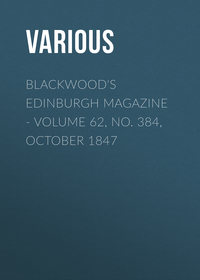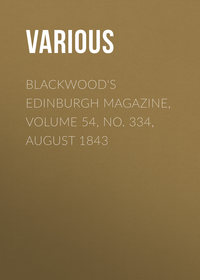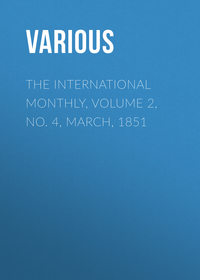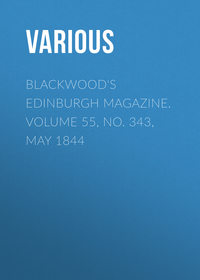 полная версия
полная версияLippincott's Magazine of Popular Literature and Science, Volume 15, No. 85, January, 1875
A well-known essay of a modern poet beautifully uses this piece of the modern machinery of his craft. Dryden here makes distance mellow the thunder of a naval fight into a musical undertone. The great sea-fight between the duke of York and the Dutch, fought within hearing of London, left "the town almost empty" of its anxious citizens, whose "dreadful suspense would not allow them to rest at home," but drew them into the eastern fields and suburbs, "all seeking the noise in the depth of silence." Dryden and three friends took a barge and descended the river. Once clear of the crowded port above Greenwich, "they ordered the watermen to let fall their oars more gently; and then, every one favoring his own curiosity with a strict silence, it was not long ere they perceived the air to break about them like the noise of distant thunder or of swallows in a chimney; those little undulations of sound, though almost vanishing before they reached them, yet still seeming to retain somewhat of their first horror which they had between the fleets. After they had attentively listened till such time as the sound by little and little went from them, Eugenius, lifting up his head and taking notice of it, was the first who congratulated to the rest that happy omen of our nation's victory."
This, the eloquent eolian music of distant and unseen battle, was unheard by the ancient cities and their chroniclers and poets. It will grow again less familiar as rifled ordnance is introduced, with its thinner and sharper style of expression. Waterloo appears to have been heard farther than Sedan or Metz, although its pieces were but popguns compared with those that spoke the requiem of the Third Napoleon. And perhaps, if we allow for smallness in number and calibre, those employed by Robert the Bruce at the battle of Werewater in 1327—said to be the first recorded occasion in Europe—were more vociferous than their successors of to-day. Few and cumbrous they must indeed have been, since Edward III. could only bring four into the field at Crécy; and they did far less service than the twanging cloth-yard shaft in deciding the event of that conflict.
It was not till centuries later that the rifle perceptibly exerted its treble voice in the multitudinous debates of the ultima ratio. Shrill as John Randolph's, its pipe, once set up, was very attentively and respectfully listened to. Like his, it spoke from the woods of America. "Stand your ground, my brave fellows," shouted Colonel Washington under the sycamores of the Monongahela on the 9th of July, 1755, "and draw your sights for the honor of old Virginia!" The colonial rifle covered the retreat of the British queen's-arm, if retreat such a rout as Braddock's could be called.
It is about the same time that we find a British writer, who had witnessed the efficiency of the rifle as a companion implement to the axe in pushing European settlement on this continent, saying, "Whatever state shall thoroughly comprehend the nature and advantages of rifle-pieces, and, having facilitated and completed their construction, shall introduce into its armies their general use, with a dexterity in the management of them, will by this means acquire a superiority which will almost equal anything that has been done at any time by the particular excellence of any one kind of firearms, and will perhaps fall but little short of the wonderful effects which histories relate to have been formerly produced by the first inventors of firearms."
This was written in 1748, at which time the rifle was used only by the hunters of the Alps and the hunters of the American backwoods; the latter having doubtless derived it from the former through German immigration. Bull's conservatism, however, was in the way. The lessons of Fort Duquesne, of Saratoga and of New Orleans were successively wasted on him. He did arm one regiment, the Ninety-fifth, with this weapon toward the close of the last century, but for a long time it stood alone in the royal service. Austria had previously maintained some corps of Tyrolese Jägers. The French fought through all the wars of their Revolution without having recourse to the rifle, save in the campaign of 1793. It is singular that the keen eye of Napoleon failed to detect its value, especially when we note the use he made of light troops. The fate of Nelson justifies the idea that a large body of good riflemen might have changed the issue of Trafalgar.
Curiously enough, the French, who were the last to realize the merits of the rifle, were the first to institute those improvements which caused, within the present generation, its universal substitution for the musket. The Gallic pioneer was Delvigne, but his first improvements proved, as Pat might say, no improvement at all. The inconvenience of slow loading was the most obvious. Delvigne's remedy was to give the ball increased windage; in other words, to diminish its diameter comparatively with that of the bore. The ball thus went easily down to the shoulders of the chamber containing the charge. Arrived there, a smart rap with the ramrod moulded it to the grooves. But it also flattened the top, and forced the bottom partly into the chamber. Thus misshapen at birth, the bullet was cast upon the world to an erratic and fruitless career.
In 1828 a second Frenchman took the tube in hand. Colonel Thouvenin abandoned the chamber, and filled up much of the place it had occupied with a cylindrical steel pillar, or tige, which projected from the breech-plug longitudinally into the barrel. This formed a little anvil whereon the bullet was to be beaten into the grooves. But the bottom was flattened, and the powder acted only on the periphery of the ball instead of the centre, tending thus to give it an oblique direction.
Here Delvigne picked up the weapon for another trial. He accomplished far the most important advance yet seen—an advance relatively as great as Watt's separate condenser in the steam-engine. He retained the tige, but he changed the spherical ball into a cylinder with a conical point, as we now have it. In this he, in effect, reached the ultimatum of progress as regards the general form of the projectile. He assimilated it to Newton's solid of least resistance. That primeval missile, the arrow, had for unnumbered centuries presented to the eyes of men an illustration of a simple truth which scientific formula succeeded, scarce a couple of centuries since, in evolving. "The bridge was built," as the old sapper told his commander, "before them picters" (the engineer's designs) "came." The arrow-head describes, as it whirls through the air, a solid varying from a cone only so far as its edges vary from straight lines. This variation serves to blend the cone with the cylinder formed by the revolution of the arrow-head and the feather. The difference in length between the ball and the arrow is due to the necessities of the case. The least practicable length is best for both. The office of the spirally-wound feather in communicating a rotary motion, and thereby balancing, by an opposite force, the tendency of the missile to swerve in any given direction, is fulfilled by the spiral groove of the rifle. Of course, the ordinary smooth musket is unfitted to the conico-cylindrical ball. Discharged from such a barrel, there being nothing to keep the point in the direction of its flight, it soon tumbles over, like an arrow without a feather, and strikes wide of the mark.
Delvigne's new gun came into use in 1840. The long matchlocks of the Arabs had been very worrying to the French in Algiers. It was a common pastime of the Ishmaelites to pick off the Gauls at a distance which left Brown Bess helpless. Protruded over an almost inaccessible crag, the former primitive instrument would plump its ball into the ranks of the Giaour in the dell below with a precision and an effect hardly requited by victories in the open field or by the cave-smokings of His Grace of Malakoff. Delvigne's arm was accordingly supplied to the Chasseurs d'Orléans, and in their hands served the desired purpose. The matchlock met its match.
Under M. Delvigne's system, however, the ball was not always well forced into the grooves. The tige, too, made cleaning difficult: it often got crooked, and it sometimes broke off. A M. Tamisier did something toward removing the former difficulty by cutting very shallow grooves on the ball itself. The other called forth the ingenuity of the now famous Minié, who made his first appearance in 1847-1848, and whose name has attained the same kind of lethal immortality with the names of Shrapnell, Congreve and Rodman. M. Minié abandoned the tige entirely. He scooped out the base of the ball and inserted into it an iron cup. This cup was driven into the ball by the explosion, and forced the soft lead into the grooves. The leading objection to the Minié ball in this form was that the device did its work too thoroughly. The iron was often driven so deep into the lead as to tear off the solid point and scatter the whole projectile into two or three pieces. This mitrailleuse-like distribution of disrupted spheres or leaden asteroids was obviated by the abandonment of the iron cup, the powder being left to act on the lead itself. Two or three channels cut around the neck of the bullet helped to keep the point in line, and aided at the same time the fastening of the cartridge. Thus came its final metamorphosis to the buzzing little torment that has been at intervals for the last twenty years flying over all the continents and perplexing the nations.
It was not till 1852 that the Enfield rifle was settled on as the standard weapon of the British army. Machinery and machinists were imported for its fabrication from the United States, the appliances of our government armories being copied, and Colonel Bruton, of the Harper's Ferry Works, employed to set them going. Prior to that time all firearms of public or private manufacture, in England, had been made by hand, the interchangeability of all the parts of any given number of guns being an end accomplished in this country alone. The advantage of having every corresponding detail of each piece a fac simile of the same part in all the firelocks of an army must have been perceived from the time when such weapons were first invented; and nothing but the most inveterate conservatism, or the steadiest opposition of that stamp which mobbed threshing-machines and the spinning-jenny, could have so long staved off its practical adoption.
Once awakened, however, England became, as she usually does, active, innovating and experimental enough. Rifled cannon, breech-loaders and armored ships—all the legitimate offspring of the Venetian barrel and its American employment—have kept her ever since in a ferment of boards, commissions and target-firing. But these would carry us beyond our prescribed limit into a boundless field of inquiry and description. It would be like passing from a notice of the tubular boiler of Stephenson's Rocket to a discussion of the vast railway system it begot.
The Crimean war afforded the first test, on a large scale, in civilized warfare, of the issue between smooth and twist. How the conoidal bullet and rifled barrel, opposed at Inkermann to the antiquated Russian musket, tore through the dense columns which had forced their way to the brow of the plateau, driving the stolid Muscovites, "incapable of panic," back into the ravine pell-mell—how, at many periods of the siege of Sebastopol, the rifle-pits did more to cripple the defence than did the mortars and battering-guns—we need not recount. These pits, and the rope mantlets wherewith they obliged the Russians to cover their embrasures, were pronounced by Captain (since General) George B. McClellan, in his report of the United States Military Commission, about the only marked novelties of the siege. Of both, mutatis mutandis, he and his opponents made effective use in our civil war.
Nor shall we pick our perilous way among the Sniders, Chassepots, Zündnadelgewehre, and Zündnadelbüchsen whose various charms absorb the military mind at this day. The debate among them is but as to the best utilization of the old arrow-theory. The oblong projectile, that goes singing on its winding way, is common to them all. Slipped in at the back door or rammed home at the front, delicately stirred up by the insinuating needle and its titbit of fulminate or bluntly ordered off by the snappish percussion-cap, it is the same obedient and faithful messenger, and goes on its appointed errand in much the same style.
Under the ancient régime of the musket it required the soldier's weight in lead to kill him. Its point-blank range was about sixty yards, but precision even at that short distance it by no means possessed. At the battle of Fontenoy the English and French Guards, drawn up in opposite lines, conversed with each other prior to firing, like two groups of friends across the street. "Gentlemen of the French Guards, fire!" was the courteous invitation of the British commander. "The French Guards never fire first," was the reply. And not till then did punctilio come to an end. Such a colloquy in our day would need to be carried on with forty-horse power speaking-trumpets, or with the thunderous articulation of that between the bellowing Alps and echoing Jura. Even smooth-bore field-pieces, with point-blank of three hundred and twenty yards and service range of one thousand, have to keep their distance. It is a rare thing now for cannon to be captured by a charge of cavalry or the bayonet. The rifle destroys quantum suff. of their horses, and, their support overpowered, they remain a helpless prey.
For this default of the blustering cannon in the trying of conclusions with its quiet little cousin, the natural remedy is to improve its interior in the same manner. This has been done, and with marvelous effect in some respects. But the rifled cannon, though extensively used both on sea and land, throwing shot and shell five miles, and at close range through iron plates a foot thick, cannot be yet styled a perfected weapon. It may be in a very few years, thanks to the ardent anxiety, on the part of the several peoples composing "the parliament of man, the federation of the world," to excel each other in the "brain-spattering, windpipe-slitting art." At present it is maintained by very good American authority that for use under some conditions, at short or moderate range, the smooth gun of large calibre is more effective than a rifled gun throwing a missile of the same weight. Our monitors continue to be armed with the fifteen-inch Rodman, very recent experiments being cited to prove its penetrating effect on iron plates greater than that of the European rifled guns. This, of course, at very close range.
The rifle is, in its simplest form, a more complex instrument than the smooth-bored piece, and will always require superior intelligence to manage it. The army which naturally possesses this requisite in the highest degree will best handle this decisive weapon, and be, other things equal, the strongest army. This consideration operates in favor of our people, among whom the rifle has always been in so much more constant and familiar use than with those of other countries. Our broad forests will have to be cleared and our mountain-chains, east and west, more densely settled than Switzerland, before the distinction of a nation of marksmen can be lost to us. So far, there is little evidence of this change. The deer and the wild-turkey are nearly as abundant on the Atlantic slope of the Alleghanies as they ever were. Probably there are more of both in Virginia than at the time of the settlement of Jamestown. Like the quail and the bee, they are favored by a certain advance of population and cultivation.
Another species of aborigine does not similarly thrive in the path of the rifle. The Indian of the Plains is still troublesome occasionally, but far less so than when blue-coats and blunderbusses joined forces against him. The odds then were often on his side, for many of the red men were armed with the rifle, while the troops had but the musket and carbine. The appearance of the breech-loading rifle in the hands of the United States dragoons on the frontier just fifteen years ago let in new light upon the Camanche and Apache mind. Up to that period the badgering of a detachment of "heavies" was a favorite pastime with these gentry. They got up their "spring fights" with as much coolness and regularity as the early patriarchs of Texas are related to have done, and not merely, as in the case of the latter, in utter contempt, but directly at the expense, of the constituted authorities. Tying a bag of dried mule-meat and pounded corn to the peak of his saddle, fashioning a small supply of arrows, or balls if he boasted the spectre of a gun, coloring the inferior half of his frontispiece a rich vermilion and the upper a delicate green, with ramifications of lampblack coursing tastefully along the cheek-bones and the bridge of the nose, twisting a crane's feather into the tail of his horse, and giving his affectionate squaw a farewell kick, the cavalier of the prairie was ready for a raid on the Long-knives. Making a rapid night-march or two, he would carry the "latest intelligence from the Indian country" to the border ranches of Texas or New Mexico. Stampeding all the horses and mules that stood or ranged convenient, and under favorable circumstances some cattle and sheep, and "gobbling" on occasion some incautious Cyrion or Phyllis of the Western Arcadia, the marauder made for the mountains. By the time he had well passed the last outpost the hue-and-cry was at his heels, followed, after an easy-going delay, by the lumbering dragoon. The soldier, armed with ineffectual sabre and carbine, encumbered with a variety of traps about as useful as they, usually managed, if not forced to put back by stress of provisions, to come up with him in the gates of the hills. There an idle interchange of arrow and round ball between hollow and cliff wound up the eventful history of the chase. As a rule, no marked chastisement was inflicted on the Indian: he realized in peace the proceeds of his little speculation.
Now, Minié, like the Harpagon of his countryman, has "changed all that." The retreating heathen flies to his hills in vain. They do not cover him, but the rifle does. Cantering to the summit of a knoll, he waves his compliments to the distant dragoon with a gesture of derision, more expressive than elegant, he has acquired from the white. Turning calmly to depart, as he sinks below the crest of the hill a sagittiform bullet, fired at five hundred yards' distance with all the science and talent purchasable with thirteen dollars a month and rations, plumps into the rump of his unhappy pony, and the Stoic of the woods is unhorsed. Reared on horseback, and weak in the legs from long addiction to that mode of locomotion, this is a casus omissus in Lo's tactics. Scant time, however, has he for reflection. He gathers up himself and his drapery as well as circumstances will allow, and scuttles hurriedly off, a fluttering chaos of rags and feathers. It is too late. Heaven is on the side of the best artillery. A few minutes and the Philistines are upon him. Burnside's or Remington's last patent again lifts up its voice, and the triumph of civilization is complete.
The prairie Indian, unlike his congener of the woods, has as yet been but partially able to substitute gunpowder for the bow. The advantage he has in the protection afforded him by the desolation of his waterless mesas and sage-covered hills is thus in great measure neutralized. What, when he does possess the modern firearm, he is capable of doing with it, the achievements of the Modocs in their volcanic stronghold will attest. But these were few, and soon went down. The extinction of the tribes west and south of the Rio Grande and the Humboldt cannot be many years postponed. The red rover of that region will disappear as a combatant in the same way, and before the same weapon, as his brother nomad of Algeria, the earliest victim of the conoidal bullet. The spherical ball has done its appointed part in disposing of the aborigines east of the Mississippi, where forests covered the land and trees generally intercepted the sight at a hundred or a hundred and fifty yards. With the extension of Caucasian empire to the Plains came an extension of the range of vision, which necessitated an advance in the range of the rifle. The weapon of Sharpe figured for the first time in the van when the woods of Missouri were passed and the open plains of Kansas reached. There its office was, unfortunately, the strife of white against white. The largest possible range, the greatest possible number of shots in a given time, were demanded in a war wherein the opposing armies were seldom within five miles of each other, or more than one man hurt to five hundred charges of powder burned. How the Lenni Lenape must have opened their eyes at this reproduction of the drama of a century ago when the whites, English and French, were fighting each other for the possession of the Delawares' lands in Pennsylvania! The feeble remnant of the compatriots of Logan had "moved on," under pressure of a very urgent police, a thousand miles westward to a reservation not a great deal larger, when portioned out, than that last reservation allotted to all men; and the pale-faces who had hung upon his track he now saw fighting for that.
From its warlike aspect it is pleasant to turn to the contributions of the rifle to peaceful amusement, if not peaceful industry. Contemptuously giving the go-by to its minutest phase in this field—the "parlor rifle," with a target against the chimney-piece or meandering, in feline form, along our neighbor's roof-tree—we go forth, with Snider and sunrise, to the forest fastness. Our companions throng, tall, bronzed, close-knit and sinewy, true children of the four-grooved, from frosty Caucasus, the Hartz, the Alps, the Dovrafjeld, the Grampians, the Himmalaya, the Adirondack, the Alleghany, the Nevada. The chamois, the ibex, the red deer, the Virginia deer, the wapiti, the gour, or the royal tiger may be the game in hand. The tiger we are accustomed to associate exclusively with the dank jungles of Lower India, but he climbs, each summer, the great passes of Central Asia, "the roof of the world," and makes his way to the frontier of Siberia, beyond 50° north.
The equipment of the mountain-rifleman is characterized by simplicity and a strict attention to business. The nature of the ground over which he works inexorably prescribes this. The superfluities of the fox-hunter or the partridge-shooter with his dog-cart cannot be his. Hatchet, pouch, knife and knapsack, with alpenstock on occasion, about comprise his kit. He may be attended by a hound or two, but not a pack. He wants no yelling. He hears but
the Spirit of the Mist,And it speaks to the Spirit of the Fell.For little hollows and little hills Scott's dogs, that
raved through the hollow pass amain,Chiding the rocks that yelled again,may have been highly effective when his mediæval sportsmen, who carried no guns, could keep within a furlong of them. But in the depths of the great mountains, with point-blank range of six hundred yards and long pops of nearly twice that, they would be preposterous. Fancy the Quorndon or the Pytchley on the flanks of the Matterhorn!
Chamois-hunting, the sporting specialty of the Swiss and the Tyrolese, appears to be dying out. The hunter of our day keeps it up rather as a tradition than as a practical pursuit. He rarely bags a "goat," for goats are very few to bag, and those few even more supernaturally fleet and sure of foot and keen of nose than their less-hunted ancestors. Still, somewhere in that upper world of lilac-white that melts into the clouds in vast but distance-softened chasms of viscid ice and rifts of gray gneiss, there is an object for him. In some nook or on some crag of the square leagues of desert that swell around him a troop of the desiderated ruminants is grazing, if grazing it can be called where grass is none. He is very sure of that. Even from the door of his chalet he scans the slopes in the half hope of detecting a flock or a single goat. His father and his grandfather before him had looked forth from the same door on the same scene, snuffed the same "caller air," mentally shaped the same pretext for yielding to the same spirit of adventure begotten of the peaks and by going forth to battle with the solitude, and hunted patiently, sometimes with success, oftener without, the progenitors of the same quarry. So he prepares himself anew for the wild and perilous tramp. A day—two or three days—may pass without the compassing of a shot, or even hearing the whistle of the sentinel goat as he shrills the alarm far out of range and leads his fellows in twenty minutes to crags the hunter cannot reach in as many hours. Death crouches in the treacherous snow-crust beneath or the poised avalanche above. A false step or an inch's miscalculation of leap may make him a waif for the lämmergeier or land him among the buried villages of the last century. He toils on until success or starvation sends him home. In the former case he out-generals his shy game after a series of manoeuvres to which the deepest stratagems of our Indians are straightforwardness personified. He gets a long shot at a distance that would make the musket or buckshot as useless as a sabre. The certainty may be apparent that the animal, if hit mortally, must fall some hundreds of feet, perhaps into an inaccessible chasm. There is no help for that. Now or never! The short rifle, assisted by a portable rest, is called on for its best. The concentrated energy of the whole chase is thrown into the long and carefully calculated aim. A thin spurt of white smoke jets forth; a sharp report echoes "from peak to peak the rattling crags among;" half a dozen chamois whisk around the next rock-buttress, and "one more unfortunate" tumbles from the verge into vacancy. The labor of days is rewarded. Securing the scanty venison if he can, the hunter is off for his hillside burrow, advertising his approach by an exultant jodel of extra nerve-splitting power.









